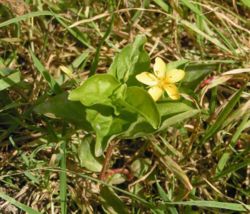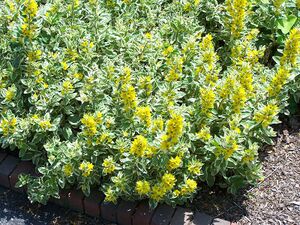Lysimachia: Difference between revisions
No edit summary |
No edit summary |
||
| Line 1: | Line 1: | ||
{{SPlantbox | |||
|genus=Lysimachia | |||
|Min ht metric=cm | |||
|Temp Metric=°F | |||
|jumpin=This is the plant information box - for information on light; water; zones; height; etc. If it is mostly empty you can help grow this page by clicking on the edit tab and filling in the blanks! | |||
|image=Upload.png | |||
|image_width=240 | |||
}} | |||
{{Inc| | |||
Lysimachia (probably after King Lysimachus). Primulaceae. Loosestrife. Erect or creeping leafy herbs grown in damp wild gardens and borders. | |||
Leaves opposite or whorled, entire, usually black punctate: fls. spicate, racemose or solitary, with a rotate or campanulate, 5-parted corolla with an equal number of slightly monadelphous stamens opposite the lobes: caps. 1-loculed, with many seeds on a central placenta. —Over 100 species found in temperate and subtropical regions of all parts of the world. Only a few in cult., and these all perennials. They differ from related genera in the absence of staminodia between the stamens, which are usually slightly united. Revision, Knuth in Das Pflanzenreich, hft. 22, p. 256 (1905). | |||
The loosestrifes are of easy culture, thriving best in moist situations. Propagation is by division in late autumn or early spring. | |||
}} | |||
{{for|the ancient town|Lysimachia (Thrace)}} | {{for|the ancient town|Lysimachia (Thrace)}} | ||
{{Taxobox | {{Taxobox | ||
Revision as of 11:30, 16 December 2009
| Lysimachia subsp. var. | ||||||||||||||||||||||||||||||||||||||||||||||||||||||||
|---|---|---|---|---|---|---|---|---|---|---|---|---|---|---|---|---|---|---|---|---|---|---|---|---|---|---|---|---|---|---|---|---|---|---|---|---|---|---|---|---|---|---|---|---|---|---|---|---|---|---|---|---|---|---|---|---|

|
|
| ||||||||||||||||||||||||||||||||||||||||||||||||||||||
| ||||||||||||||||||||||||||||||||||||||||||||||||||||||||
| Standard Cyclopedia of Horticulture |
|---|
|
Lysimachia (probably after King Lysimachus). Primulaceae. Loosestrife. Erect or creeping leafy herbs grown in damp wild gardens and borders. Leaves opposite or whorled, entire, usually black punctate: fls. spicate, racemose or solitary, with a rotate or campanulate, 5-parted corolla with an equal number of slightly monadelphous stamens opposite the lobes: caps. 1-loculed, with many seeds on a central placenta. —Over 100 species found in temperate and subtropical regions of all parts of the world. Only a few in cult., and these all perennials. They differ from related genera in the absence of staminodia between the stamens, which are usually slightly united. Revision, Knuth in Das Pflanzenreich, hft. 22, p. 256 (1905). The loosestrifes are of easy culture, thriving best in moist situations. Propagation is by division in late autumn or early spring.
|
| Lysimachia {{{status}}} Fossil range: {{{fossil_range}}}
| ||||||||||||||||||||||||||||||||||||||||||||||||||||||||||||||||||
|---|---|---|---|---|---|---|---|---|---|---|---|---|---|---|---|---|---|---|---|---|---|---|---|---|---|---|---|---|---|---|---|---|---|---|---|---|---|---|---|---|---|---|---|---|---|---|---|---|---|---|---|---|---|---|---|---|---|---|---|---|---|---|---|---|---|---|
 Yellow pimpernel, Lysimachia nemorum | ||||||||||||||||||||||||||||||||||||||||||||||||||||||||||||||||||
| Plant Info | ||||||||||||||||||||||||||||||||||||||||||||||||||||||||||||||||||
| ||||||||||||||||||||||||||||||||||||||||||||||||||||||||||||||||||
| Scientific classification | ||||||||||||||||||||||||||||||||||||||||||||||||||||||||||||||||||
| ||||||||||||||||||||||||||||||||||||||||||||||||||||||||||||||||||
| [[{{{diversity_link}}}|Diversity]] | ||||||||||||||||||||||||||||||||||||||||||||||||||||||||||||||||||
| {{{diversity}}} | ||||||||||||||||||||||||||||||||||||||||||||||||||||||||||||||||||
| Binomial name | ||||||||||||||||||||||||||||||||||||||||||||||||||||||||||||||||||
| {{{binomial}}} | ||||||||||||||||||||||||||||||||||||||||||||||||||||||||||||||||||
| Trinomial name | ||||||||||||||||||||||||||||||||||||||||||||||||||||||||||||||||||
| {{{trinomial}}} | ||||||||||||||||||||||||||||||||||||||||||||||||||||||||||||||||||
| Type Species | ||||||||||||||||||||||||||||||||||||||||||||||||||||||||||||||||||
| {{{type_species}}} | ||||||||||||||||||||||||||||||||||||||||||||||||||||||||||||||||||
| Species | ||||||||||||||||||||||||||||||||||||||||||||||||||||||||||||||||||
| include: Lysimachia nemorum (yellow pimpernel) | ||||||||||||||||||||||||||||||||||||||||||||||||||||||||||||||||||
| [[Image:{{{range_map}}}|{{{range_map_width}}}|]] | ||||||||||||||||||||||||||||||||||||||||||||||||||||||||||||||||||
| Synonyms | ||||||||||||||||||||||||||||||||||||||||||||||||||||||||||||||||||
| {{{synonyms}}} |
Lysimachia is a genus of flowering plants. It is traditionally classified in the family Primulaceae but should, according to molecular phylogenetic study, be placed to the family Myrsinaceae [1].
Characteristics
Lysimachia species often have yellow flowers, and grow vigorously. They tend to grow in damp conditions. Several species within Lysimachia are commonly called loosestrife, although this name is also used for plants within the genus Lythrum.
Lysimachia species are used as food plants by the larvae of some butterflies and moths, including the Dot Moth, Grey Pug, Lime-speck Pug, Small Angle Shades and V-pug.
Species
Species within the genus include:
- Lysimachia atropurpurea (purple gooseneck loosetrife)
- Lysimachia ciliatum (fringed loosestrife)
- Lysimachia clethroides (gooseneck loosestrife) — a hardy perennial resembling a tall Speedwell and growing up to 3 feet (1 metre). Flowers from July on to September. Grows best in deep, rich loam in a sheltered position.
- Lysimachia fraseri (Fraser's yellow loosestrife, endangered)
- Lysimachia nemorum (yellow pimpernel)
- Lysimachia nummularia (creeping Jenny or moneywort) — extremely hardy, and easy to cultivate; every piece of the creeping root will, if taken off, make a fresh plant.
- Lysimachia punctata (spotted loosestrife)
- Lysimachia quadrifolia (whorled loosestrife)
- Lysimachia terrestris (swamp candles)
- Lysimachia vulgaris (garden or yellow loosestrife)
Reference
- ↑ M. Källersjö, G. Bergqvist & A. A. Anderberg (2000). "Generic realignment in primuloid families of the Ericales s. l.: a phylogenetic analysis based on DNA sequences from three chloroplast genes and morphology". American Journal of Botany 87 (9): 1325–1341.
External links
- Lysimachus' Dog & Nisaean Horses - Informative but non-scholarly essay on Lysimachia & Lysimachus (Annotated with Sources).
